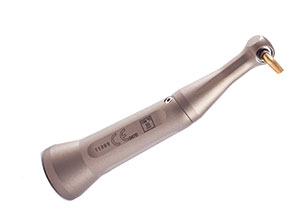Placing a permanent fixed bridge immediately after extraction has always been a tricky and difficult aesthetic procedure due to the uncertainty, and potential extent, of ridge resorption. We know that after extraction, 40% to 60% of bone loss occurs in 2 to 3 years, thereby severely jeopardizing aesthetic and functional restorative results. Fortunately, due to the availability of modern grafting materials, the bridge procedure has become much more predictable and simple. Placing an immediate, postextraction, synthetic bone graft into an existing extraction site is within the capabilities of most general dentists. The capability to provide an immediate, permanent fixed prosthesis in a matter of weeks, not months, with dependable, predictable gingival stability is of enormous value.
The following is a case report that demonstrates a present-day approach to handling extractions and the resulting aesthetic restorative bridge technique.
CASE REPORT
The patient presented with a 6-unit fixed prosthesis replacing tooth No. 9. All of the abutment roots had recurrent decay. Tooth No. 8, with root canal treatment and post, was hopeless and required extraction. Tooth No. 10 had extensive decay requiring root canal therapy (Figures 1 and 2). The presence of caries was confirmed by x-ray, probing, and high DIAGNOdent (KaVo) readings. After discussing all options with the patient, we decided to extract tooth No. 8, place an immediate synthetic bone graft, perform root canal therapy on tooth No. 10, and prepare the abutment teeth for a new prosthesis to be delivered approximately 2 weeks postoperatively.
Anesthesia was administered, a root canal was performed on tooth No. 10, and tooth No. 8 was extracted with care to preserve as much of the buccal plate as possible. After the extraction, Bioplant HTR (Kerr) synthetic bone replacement was placed into the socket. The graft site was covered with Gelfoam (Upjohn) and cross-sutured. Figures 3 and 4 show the immediate postoperative result. Notice the original overprepped abutments. A post and buildup was performed on tooth No. 10. Preps were defined. A final impression was made for the replacement fixed splint. Figure 5 is just prior to seating the final 6-unit splint, taken 2.5 weeks postoperatively. Notice the healthy tissue and lack of shrinkage. While healing, the patient was placed on Periostat (CollaGenex Pharma-ceuticals) twice a day and was instructed to brush with Dental Herb Tooth and Gum toothpaste (Dental Herb Company) and rinse with mouthwash 5 times a day. We have had ex-tremely good results utilizing this regimen.
A similar case demonstrates how easy it is to place a Bioplant HTR synthetic graft. The material is simply expressed from a plastic syringe; the graft material is placed into the extracted site and covered with Gelfoam. Biofoil oral bandage (Kerr) can be used over the graft site (Figures 6 to 8), or simple cross-suturing can keep the Gelfoam in place. We usually cross-suture on anterior cases, as it is more aesthetic. More information on Bioplant HTR is available at bioplanthtr.com. This procedure is very simple for the general practitioner to perform. The patient does not have to wear a thumb-plate or have an expensive graft performed by a specialist, and it can be accomplished in a matter of a few weeks!
Figures 9 and 10 show the results just 2.5 weeks after surgery. Notice the lack of gingival shrinkage. The patient’s smile has been restored in a short period of time, and no thumb plate was utilized. This procedure was simple, extremely beneficial for the patient, and profitable for the practice—a win-win procedure for all concerned.
Figure 11 was taken ap-proximately 2.5 years after the procedure. There has been no more recession from the grafted site, aesthetics are fine, and gingival health is self-evident. The patient has remained on routine hygiene care, oral irrigation using the ShowerFloss (ShowerFloss), and the Tooth and Gum products. We have found that the use of an oral irrigator such as the Shower-Floss (very convenient), the HydroFloss (HydroFloss), or the Panasonic portable oral irrigator, to mention a few, greatly reduces the recurrence of root caries around crown and bridge work, as was evident in this case.
Currently, practitioners are charging a minimum of $500 for 1 extraction site—less (per site) for multiple sites.
 |
 |
| Figure 1. Preoperative photo. | Figure 2. X-ray showing extensive root decay of tooth No. 8. |
 |
 |
| Figure 3. Immediate postoperative graft. | Figure 4. Bioplant material in place. |
 |
 |
| Figure 5. Note healthy tissue and lack of shrinkage. | Figure 6. Bioplant HTR placed in socket. |
 |
 |
| Figure 7. Gelfoam placed over Bioplant. | Figure 8. Biofoil placed over graft site. |
 |
 |
| Figure 9. Two-and-a-half weeks postoperatively. | Figure 10. Two-and-a-half weeks postoperatively, retracted view. |
 |
| Figure 11. Two-and-a-half years postoperatively. |
CONCLUSION
The procedure demonstrated in this article is very easily accomplished by the general practitioner, is extremely beneficial for patients, and is extremely rewarding for the dentist and his or her practice.
Acknowledgment
The author would like to thank Mickey Singletary Conracts’ lab work for Singletary Labs in League City, Tex.
Dr. Groba has a private practice in Friendswood, Tex. He has lectured internationally on practice management and technical topics. He and his staff give a 1-day, over-the-shoulder course for doctors and their staff members, which is accredited for 8 hours of continuing education. For more information, call (800) 569-5245.











